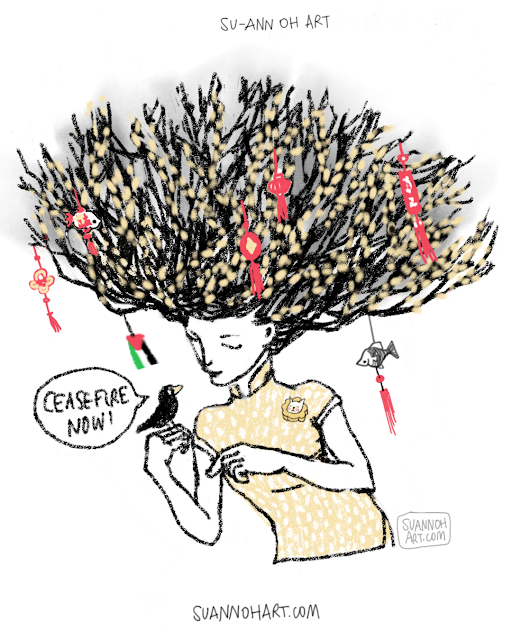How to design and print unique packaging on a budget? Freebie card included
Being creative within a set of constraints
So, it was an exciting opportunity to design packaging for Postcards from Chip Bee. I wanted to keep the postcards from getting dirty during delivery, but I also had a set of parameters based on my desire to keep waste and cost to a minimum. My considerations were:- How could I re-use or re-cycle as much as possible so as not to create waste?
- How could I create a design that would match the look and style of the postcards and the text?
- How could I recreate the design quickly and inexpensively?
I found a stack of envelopes and decided to put the postcard sets in them. The envelopes were plain and I wanted a look for them that would complement the cheerful quirkiness of the drawings. Also, I wanted to be able to reproduce the design easily and at reasonable cost.
Why linocut fit the bill
Hmm, I thought, what can I do that won't require me to draw on every envelope, and that will not create too much unwanted waste? Hah! Linocut printing. |
| Designing packaging for Postcards from Chip Bee |
Linocut printing is basically the same technique as woodcut printing except that a piece of linoleum or rubber is used for cutting. It's a technique that's been used since the mid-1800s and it is very simple to do.
The first step is to draw out a design and transfer it onto the linoleum or rubber, in my case rubber. Then, using cutting tools, the rubber is cut away to form a stamp. With this stamp, you can print on paper or fabric as many as times as desired.
I've always wanted to do linocut printing. I love the idea of designing something and being able to print it as many times as I want. With drawings and paintings, I am reliant on a printer to make copies. But with linocut, I own and control the means of production. I alone decide on the quality of the prints and when they are done as I do the printing myself.
 |
| My cheapo linocut tools |
Also, there's something special about handmade prints. Have you ever seen different copies of Japanese woodcut prints? There is a slight difference in colour and texture because each print is handmade. If there is not enough paint, this shows up in the print. And if the layers of colour are not properly aligned, it shows up too. These inconsistencies make each print unique.
The other thing about linocut also is that it is very reasonable in terms of set up costs. The tools cost about $5 and the linoleum costs between $5 and $20, and it is meant to be used over and over again.
Some tips for doing linocut
I remembered that I had bought a block of linoleum and the tools for linocut a few years ago with the intention of playing with them. But I had stored them in my art supply cupboard and promptly forgotten about them. So, I hurried over to my art materials and rummaged around for the tools and got to work.
I began by carving a stamp of a cat because it's a simple design and there are lots of cats in Chip Bee Gardens. I also made a stamp of a monstera leaf because the neighbourhood is full of tropical plants.
And then I decided to do some text. I'd watched many YouTube videos of people carving stamps, and I was aware that text had to be laterally inverted. I was too lazy to make a drawing first and copy it onto the rubber block. So, I wrote the text backwards on the rubber block. As you can see, my first attempt at carving text didn't quite turn out right. This must be how it feels to have dyslexia.
I began by carving a stamp of a cat because it's a simple design and there are lots of cats in Chip Bee Gardens. I also made a stamp of a monstera leaf because the neighbourhood is full of tropical plants.
And then I decided to do some text. I'd watched many YouTube videos of people carving stamps, and I was aware that text had to be laterally inverted. I was too lazy to make a drawing first and copy it onto the rubber block. So, I wrote the text backwards on the rubber block. As you can see, my first attempt at carving text didn't quite turn out right. This must be how it feels to have dyslexia.
 |
| First attempt at carving out text - fail! |
I repeated the text carving making sure to turn the B into a D, or rather the other way around - argh, so confusing!
 |
| Linocut success! |
I was also careful to keep my fingers behind the cutting tool to avoid being cut. It helps to move the rubber so that you are always cutting away from you. I think that's the most important lesson!
Having fun
And I am hooked. It's so fun and there's something therapeutic about the repetitiveness of carving out the rubber.I played with the stamps and made these greeting cards.
You can download the Monstera card here and the Miao card here for free. Print them out, cut them to size and give to them friends.*
* You can print as many copies as you like as long as they are for personal use. I own the copyright and if you would like to use them for commercial purposes, please contact me here.
Let me know if your friends like the cards!
And if you want more linocut inspiration, you might like to follow these artists on Instagram Viktoria Astrom, Lili Arnold, Andrea Lauren, Brian Reedy.
If you create some linocut art, let me have a peek at it. Put your link in the comments below.










Comments
Post a Comment